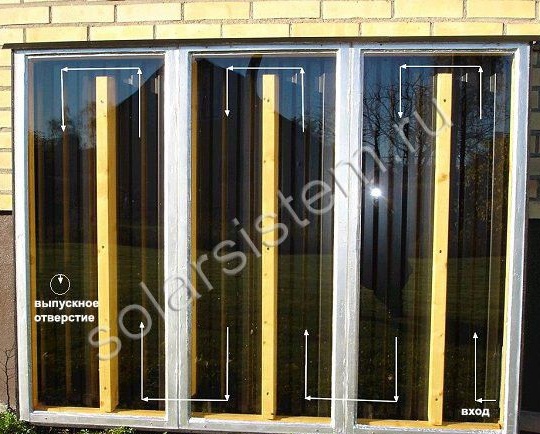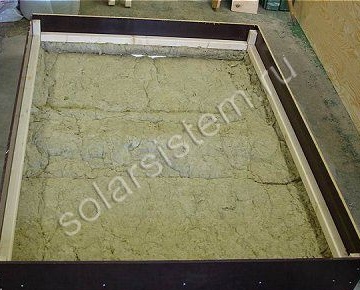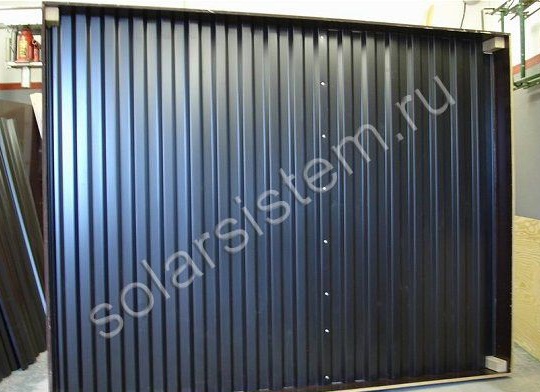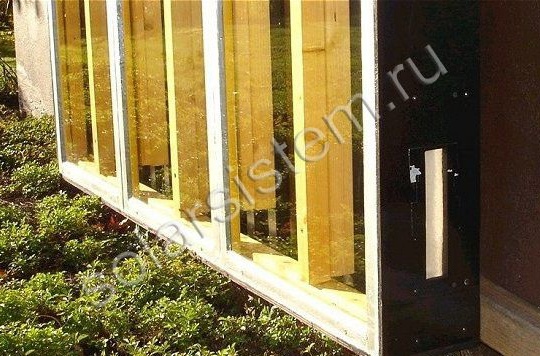
The author of this collector model did not want to make complex communications from pipes for heating indoor air. However, he was interested in the idea of using air solar collectors. Therefore, he decided to assemble a simplified air heating system due to the energy of the sun, which would not take so much time and effort to build it.
The materials that were used by the author to build a simplified model of the solar air collector:
1) several sheets of moisture-proof plywood 12 mm and 7 mm thick
2) wooden bars 40 by 40 mm
3) mineral wool
4) black heat resistant paint
5) glass from old window frames
6) mosquito net
7) fan
Consider the main features of this design of the solar air collector, as well as the process of its assembly.
The advantage of such a system is that only one hole in the wall is required in order for hot air from the collector to enter the heated room. Air intake to the collector will be carried out directly from the street.
The design of this collector is much easier than those that were described in previous articles, however, schematically they are all similar. As in previous versions, the base of the solar collector will consist of an absorber enclosed in a box.
The author decided to make the collector case from moisture resistant plywood. As the side walls, plywood sheets 12 mm thick were used. For the back wall, the author took the plywood a little thinner, about 7 mm. The author himself decided to make the box itself quite large, its height would be 120 cm, a width of 15 cm and a length of 180 cm. After assembling the box, the author attached wooden bars around the entire perimeter of the case to the back wall of the structure. The size of the bars used was 40 by 40 mm. A heater was placed between the back wall and the bars, in this case the author decided to use a layer of mineral wool. The thickness of the mineral wool layer was about 4 cm.

Then the author installed a sheet of metal corrugated board inside the box. The size of the corrugated board should be just according to the internal size of the box, and it is fixed on the same wooden bars sheathed around the inner perimeter of the box.
After installing the corrugated board inside the box, the author proceeded to paint it. To paint corrugated board, the author used heat-resistant black paint.

In order to increase the time spent by the air inside the collector, the author attached several boards inside the collector. The boards are selected of the same width as the collector, so that there are no gaps between the glass and the metal part of the collector, and the length of the board is specially made slightly less, thus leaving small passages for the movement of air masses. As shown in the following picture, thanks to this approach to the interior of the collector, a kind of maze was created for the incoming air. This feature allows the corrugated sheet to transfer more thermal energy to the air, as it lingers longer inside the collector.

For air intake from the street, a technological hole was made in the side of the collector. This hole was covered with a mosquito net, in order. so that insects and other living creatures do not get inside the solar collector.
As already mentioned, the entire structure must be covered with glass; the author used the usual old window frames. The glass was attached to silicone glue, after which all the cracks were carefully sealed so that there were no leaks of hot air from the system.
After that, the design of the solar collector is almost ready, it remains only to install the fan on the inlet of the collector. With this fan, it will be possible to adjust the speed of the air mass in the manifold. Thus, the rays of the sun will heat the corrugated sheet, which in turn will transfer heat to the air, which will enter the collector from the street, after which the heated air will already enter the house.

The main disadvantage of this model is that air enters the collector from the external environment, and not from the room, which means that much more energy will be required to heat it. Here are the results of tests conducted by the author of this solar collector: at an ambient temperature of + 10 ° C, the temperature of the air passing through the collector will be approximately + 55-65 ° C, and when the temperature of the external air is + 5 ° C, the temperature of the air coming from the collector the house will be approximately + 35-45 ° C. That is, the lower the temperature outside the window, the more difficult it will be for the air collector to heat it. Naturally, all tests were carried out exclusively in sunny weather, when the collector's work was as efficient as possible.
